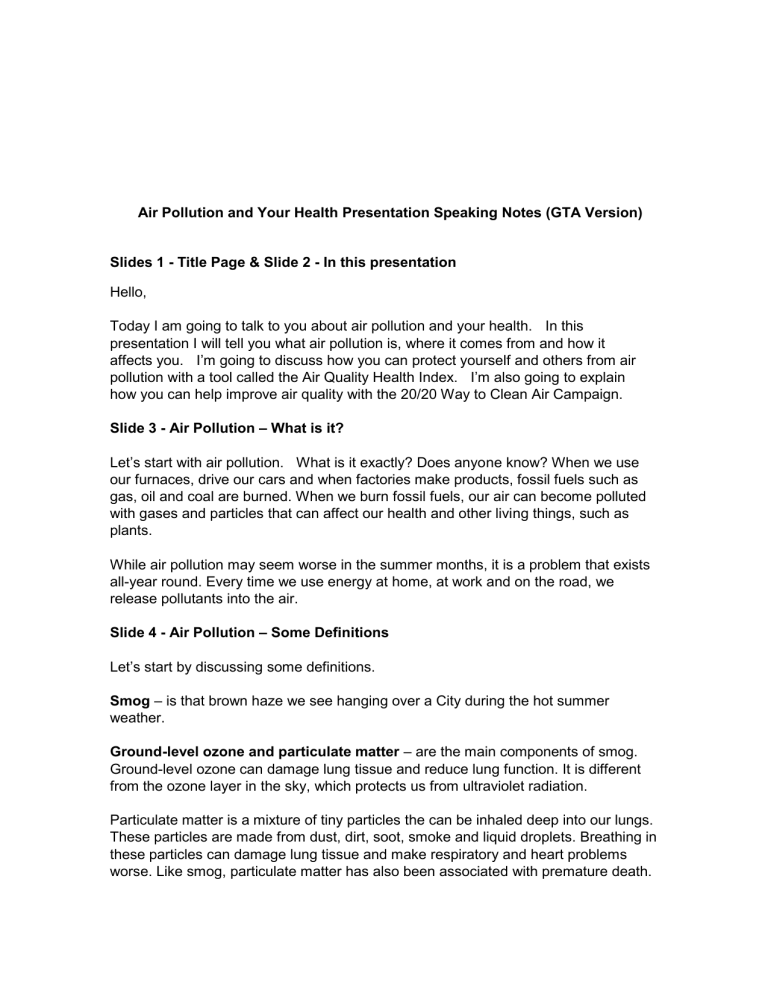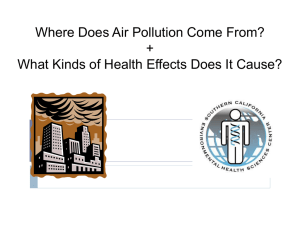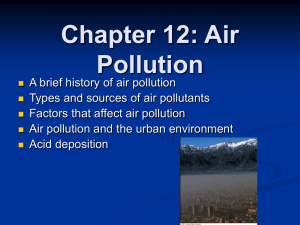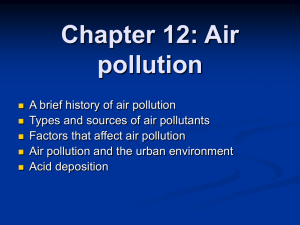GTA PowerPoint Presentation Speaking Notes.pages

Air Pollution and Your Health Presentation Speaking Notes (GTA Version)
Slides 1 - Title Page & Slide 2 - In this presentation
Hello,
Today I am going to talk to you about air pollution and your health. In this presentation I will tell you what air pollution is, where it comes from and how it affects you. I’m going to discuss how you can protect yourself and others from air pollution w ith a tool called the Air Quality Health Index. I’m also going to explain how you can help improve air quality with the 20/20 Way to Clean Air Campaign.
Slide 3 - Air Pollution
– What is it?
Let’s start with air pollution. What is it exactly? Does anyone know? When we use our furnaces, drive our cars and when factories make products, fossil fuels such as gas, oil and coal are burned. When we burn fossil fuels, our air can become polluted with gases and particles that can affect our health and other living things, such as plants.
While air pollution may seem worse in the summer months, it is a problem that exists all-year round. Every time we use energy at home, at work and on the road, we release pollutants into the air.
Slide 4 - Air Pollution
– Some Definitions
Let’s start by discussing some definitions.
Smog
– is that brown haze we see hanging over a City during the hot summer weather.
Ground-level ozone and particulate matter
– are the main components of smog.
Ground-level ozone can damage lung tissue and reduce lung function. It is different from the ozone layer in the sky, which protects us from ultraviolet radiation.
Particulate matter is a mixture of tiny particles the can be inhaled deep into our lungs.
These particles are made from dust, dirt, soot, smoke and liquid droplets. Breathing in these particles can damage lung tissue and make respiratory and heart problems worse. Like smog, particulate matter has also been associated with premature death.
Nitrogen Dioxide – is a highly reactive gas that contributes to the formation of smog and particulate matter. It can irritate the lungs, cause bronchitis and pneumonia and lower resistance to lung infections.
Slide 5 – Sources of Air Pollution
Over the past century, humans have developed a lot of technologies that have improved our lives in many ways. The car is one such innovation that has opened up the world in ways we couldn’t have imagined 100 years ago. However, with so many vehicles now on the road, it is one of the largest sources of air pollution. Other sources are: our use of electricity; the gas and oil that heats and cools our homes; and the industry processes needed to make the hundreds of products we can buy off the shelf.
Slide 6 – Air Pollution and Health
How does air pollution affect our health? Well, according to a study of eight
Canadian cities, Health Canada estimated that 5,900 premature deaths and thousands of hospitalizations can be linked to air pollution each year.
1
Plus, it makes heart problems, asthma, allergies and bronchitis worse. It irritates our eyes, nose and throat, and makes it difficult for even healthy lungs to work well.
For premature deaths in your area, please see the chart below:
This data is derived from the Ontario Medical Association’s (OMA) Illness Cost of Air
Pollution (ICAP) Model. The data illustrates premature smog deaths by census district for the year 2008. http://www.oma.org/media/news/pr080606b.asp
Premature Smog Deaths in Ontario in 2008
Algoma
Brant
Bruce
Cochrane
Dufferin
Durham
Elgin
Essex
Frontenac
13
0
10
8
Niagara
Nipissing
68 Northumberland
70 Ottawa-Carleton
37 Oxford
38
1
Parry Sound
71 Peel
31
7
10
7
Perth
Peterborough
83 Prescott and Russell
99 Prince Edward
425
67
81
503
93
41
700
66
119
Grey
Haldimand-Norfolk
Haliburton
Halton
18 Rainy River
33 Renfrew
6
Hamilton-Wentworth 44 Simcoe
5
Slide 7 – Air Pollution and Climate Change
3
49
25
14
76
299
86
What’s our air going to be like in the future? Well, it is expected that air pollution will get worse because of climate change.
20
Kent 10 Thunder Bay 122
Has anyone ever heard of climate change? Climate change is a shift in weather
Lambton 12 Timiskaming 32 conditions over a period of time. It is caused mostly because of the burning of fossil
Lanark
5
213
Premature Smog Deaths in Ontario in 2008 0
Niagara
Lennox and Addington 348
Middlesex
Bruce
Nipissing
York 590
Dufferin
Durham
Elgin
Essex
Frontenac
Grey
Haldimand-Norfolk
Haliburton
Halton
Hamilton-Wentworth
54
81
503
Total Deaths in Ontario 93 37 Oxford
38
1
Parry Sound 41
700
66
71 Peel
31 Perth
7
10
7
Peterborough
83 Prescott and Russell
99 Prince Edward
18 Rainy River
33
6
44
Renfrew
Simcoe
119
49
25
14
76
299
Huron
Kenora
Kent
3
60 Sudbury District
34 Sudbury Regional Municipality
10 Thunder Bay
118
20
122
temperatures could rise by 1 to 6.5°C over this century.
2
Now the problem is, higher temperatures help in the formation of a pollutant called ground-level ozone. Ozone is a very reactive gas that attacks lung tissue. It is the main ingredient of smog and is harmful to breathe.
In Toronto, research shows the number of deaths that are linked to air pollution could go up by 20% in 2050, in large part because of increased ozone levels due to higher temperatures.
3
Slide 8 – Some People are More Sensitive to Air Pollution
Some people are more sensitive to the effects of air pollution. They include young children, the elderly, people with asthma, people with heart and lung conditions, diabetics and people who work or exercise outdoors.
Children are at greater risk because they have less developed lungs and inhale more air compared to adults. They also spend more time outdoors.
Seniors are more at risk not only because of their age but also because they are more likely to have health problems such as heart and lung disease.
Even healthy people may have difficulty breathing, especially if they exercise outdoors when there are high levels of air pollution.
Slide 9
– How can we take action?
What can we do about air pollution? Well here are two things: 1) We can protect our health by using a tool called the Air Quality Health Index; and 2) We can learn how to pollute less with the help of the 20/20 The Way to Clean Air campaign.
Slide 10
– What is the Air Quality Health Index?
The Air Quality Health Index is a tool that helps you plan your outdoor activities based on the quality of the air. On a scale from 1 to 10, it tells you what the health risk is according to the level of air pollution. For example, a reading of 1 means “low risk” so this would be a great time to get out and exercise. A reading of 7, however, means the health risk is high and so you might want to reduce or reschedule your outdoor activity.
It measures three pollutants: ground-level ozone, particulate matter and nitrogen dioxide. These pollutants are measured because they were found to have the most impact on human health.
This index is a great planning tool because the values are updated each hour and it provides an afternoon and next day forecast.
Slide 11
– What it Looks Like
This is the colourful scale that you will see when you go to the Air Quality Health Index web site at www.airhealth.ca
. As you can see, the higher the number on the scale, the higher the health risk is from air pollution.
Each number on the AQHI scale comes with two separate pieces of health advice, one for the general population and one for people that are more sensitive to air pollution.
Can someone tell me who those people are? (Young children, the elderly, people with asthma, people with heart and lung conditions, diabetics and people who work or exercise outdoors).
On this particular day, the reading was a 4, which means moderate health risk. This
value is updated each hour so it is kept very current. Looking just below the 4, you will see messages for people considered “at risk” and messages for those who are part of the general population. People with heart or breathing problems have the highest risk of health impacts from air pollution. At this level, the messages for both populations are different. For the atrisk population the message is “If you have heart or breathing problems, and experience symptoms, consider reducing physical exertion outdoors or reschedule activities to times when the index is lower.” For the general population the message is, “No need to modify your usual outdoor activities.”
The bottom half of the screen provides the forecast for later in the day and for the following day. On this day, the afternoon forecast is a 6 so if you have asthma, you may want to reschedule an activity like jogging or cycling until later in the evening.
Slide 12 – What do the numbers mean?
This chart shows you more detailed messages for both groups – the “at risk” and the
“general” population. If you have a heart or breathing problem and the current reading is a 4, 5, or 6, you may want to consider reducing or rescheduling strenuous activities outdoors if you are experiencing symptoms. However, if you are a healthy adult and considered part of the general population, there is no need to modify your activities at this level.
As you move up to the scale to higher risk levels at 7-10 or Above 10, children and the elderly become part of the “at risk” population. At these levels, children are vulnerable because their lungs are growing and the elderly at risk of serious impacts because of their aging lungs and heart. So the messages become much stronger as the numbers get higher, especially for those considered at risk. Reduce, reschedule or avoid outdoor activities become the key messages for protecting health.
Slide 13 – How to Use the Air Quality Health Index
Here’s how you use the Air Quality Health Index:
Step 1
•
•
Step 2
Use the maximum forecasts to plan outdoor activities ahead of time
Check the hourly AQHI as you go about your everyday activities
Listen to your body. At what number do you start to feel symptoms?
Someone with asthma may feel symptoms at 6; an elderly person with heart problems may feel symptoms at 4. Reduce or reschedule outdoor activities based on how you feel
Step 3 Follow the health advice in the corresponding health messages
Step 4 Read the “Did you know…?” facts
Slide 14 - Which personal daily activities can you use the Air Quality Health Index to plan for?
Now, what personal daily activities can you use the Air Quality Health Index to plan for?
Note to Speaker : Get the audience to talk about activities they can plan using the
Air Quality Health Index. The goal is to get people to think of personal life examples of when the Index can help them minimize their health risk from air pollution.
Examples could be walking, playing soccer, running, etc.
Slide 15
– Where can you find the Air Quality Health Index?
1. Go to www.airhealth.ca
2. When you get to the web site, click on “your local conditions” and then you will find a colourful map that will take you to your province and then your city.
Slide 16 – Air Quality Health Index Monitoring Stations
There are currently 10 Air Quality Health Index monitoring stations in the GTA (40 in
Ontario):
•
•
•
•
•
•
•
Burlington
Oakville
Mississauga
Brampton
North, East, West and South Toronto
Newmarket
Oshawa
Slide 17
– 20/20 The Way to Clean Air – Taking action to reduce air pollution
The Air Quality Health Index is a great tool for protecting our health on the days when pollution levels are high. However, it is important for all of us to be working at reducing the problem of air pollution in the first place.
20/20 is a program that will help you take action to improve air quality in your city. It provides easy-to-use tools to help people reduce home energy use by 20% and vehicle use by 20%, which is why it is called 20/20! And ultimately, if enough people participate in 20/20, we may have fewer days when the Air Quality Health Index reaches the “high risk” levels.
20/20 has a school-based program as well that ties nicely into the Grade 5
Science curriculum. It includes a student booklet, in-class lessons, colourful posters and stickers and on-line support.
Slide 18 – The 20/20 Planner
The main tool of the 20/20 program is the 20/20 Planner. It is a booklet that includes easy-to-use checklists with many activities that help you reduce your energy consumption, both at home and on the road. The Home Energy checklists recommend simple actions such as turning out lights and washing clothes in cold water. It also has a checklist that outlines longer-term actions, such as draft-proofing your home and insulating the attic. 20/20 also has tips for people who live in apartments and condominiums, so everyone can participate in this program.
The 2 nd
part of the 20/20 Planner provides a plan for helping people get on the transit, walk, cycle and carpool more. Having families work toward a 20% reduction in their vehicle use is the ultimate goal. 20/20 also connects participants to a list of additional services and incentives in their community to help them reach their energy savings goals.
The 20/20 Planner is provided free to residents and can be ordered through the regional coordinator for the campaign – The Clean Air Partnership.
Slide 19 – For More Information, Contact Your Local Health Unit
Public Health Unit(s) website links
Slide 20
Thank you. Any questions?
References
1
Judek, S., B. Jessiman, D. Stieb, (2004) Air Health Effects Division, Health Canada and R. Vet, Meteorological Service of Canada, Environment Canada. Estimated
Number of Excess Deaths in Canada Due to Air Pollution. Available at: http://www.metrovancouver.org/about/publications/Publications/ AirPollutionDeaths.pdf
2
Environment Canada. Climate Change 101. Available at: http://
3 www.environment-canada.ca/cc/default.asp?lang=En&n=8C8FDAA0-1
Cheng, S., Campbell, M., Li, Q., Guilong, L., Auld, H., Day, N., Pengelly, D., Gingrich,
S., Klaassen, J., MacIver, D., Comer, N., Mao, Y., Thompson, W. and Lin, H. (2005):
Differential and combined impacts of winter and summer weather and air pollution due to global warming on human mortality in south-central Canada; Health Canada, Health
Policy Research Program, Project Number 6795-15-2001/4400011, technical report.
Glossary
Climate Change
Climate Change is a long-term shift in average weather conditions over time, including temperature, precipitations, winds and other indicators. The impacts of climate change are far-reaching, affecting our infra-structure, weather patterns, wildlife and landscapes. Climate change is occurring primarily as a result of human activities, in particular the burning of fossil fuels to heat, cool and light homes and power motor vehicles.
Smog
Smog is a mixture of pollutants in the air, including gases and particles that are too small to see. The two main pollutants in smog are ground-level ozone and particulate matter. Smog often looks like a brown haze and has been identified as a contributing factor to thousands of premature deaths and hospitalizations across the country.
Ground-level ozone
This gas is the result of a chemical reaction when certain pollutants are combined in the presence of heat and sunlight. Ground-level ozone shouldn't be confused with the ozone layer in the sky, which protects us from ultraviolet radiation. It is the major component in smog and has been found to damage lung tissue, reduce lung function and makes the lungs sensitive to other irritants.
Particulate Matter
Particulate matter is a mixture of tiny airborne particles that can be inhaled deep into the lungs. PM varies in size. In general, the smallest particles pose the highest human health risks. PM exposure can affect breathing, aggravate existing respiratory and cardiovascular disease, alter the body's defence systems against foreign materials, and damage lung tissue, contributing to cancer and premature death.
Particulate matter (PM) includes dust, dirt, soot, smoke and liquid droplets.
Nitrogen Dioxide
Nitrogen dioxide (NO2) is a brownish, highly reactive gas that is present in all urban atmospheres. NO2 can irritate the lungs, cause bronchitis and pneumonia, and lower resistance to respiratory infections. NO
2
contributes to the formation of ground-level ozone and PM








